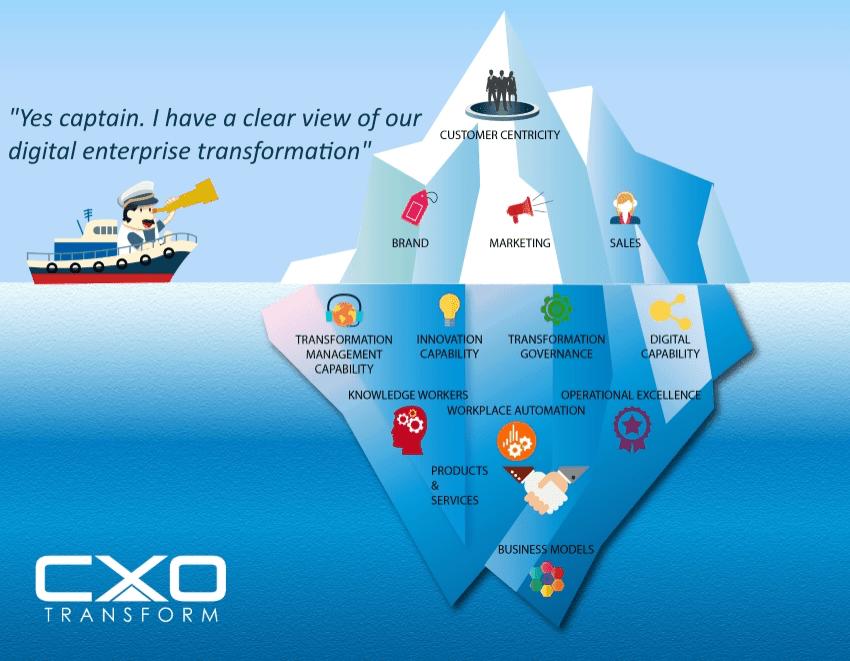6 Guiding Principles of Digital Transformation

Digital transformation is crucial to navigating twenty-first-century business demands. Implementing digital transformation will empower an entire workforce to work seamlessly together, leveraging technology to achieve shared goals.
In this blog post, Rob Llewellyn will show you how not to lose sight of the big picture of digital transformation. You will learn the six principles of digital transformation that are relevant to any organization with a digitalization strategy. These principles—the components of the THRIVE Digital Transformation Framework—will help you better imagine digital transformation as the sum of its parts. Llewellyn is a distinguished consultant with a focus on digital transformation, and the framework he outlines in this post is enormously clarifying.
Read on to learn more about how to navigate digital transformation:
Navigating digital transformation in its entirety
Digital transformation is the ongoing practice of implementing new technologies and processes comprehensively and strategically across an organization. Embracing digital transformation helps organizations become more innovative, responsive, and efficient.
When it comes to digital transformation, it’s important not to lose sight of your mission as an organization. Here’s an example that will illustrate why it is vital to consider digital transformation in its entirety rather than hyper-focus on one of its components over another:

The digital transformation iceberg uses Sigmund Freud’s iceberg analogy to illustrate how the conscious mind of digital leaders should be focused on far more than the tip of the digital iceberg. The alternative might be likened to the disaster that struck the mighty Titanic on its maiden voyage in 1912.
The iceberg is designed to encourage leaders to look beneath the surface and approach digital transformation holistically. It helps leaders approach digital transformation with an open mind and primed to answer the question “what should we transform and how?”
Look beneath the surface and approach digital transformation holistically.
It’s worrying when some suggest the CMO should be the only one to initiate a digital transformation unless the CMO is sufficiently equipped and prepared to address all that sits below the surface of the digital transformation iceberg. Many firms fall into the trap of appointing someone with a very narrow view of digital transformation to lead the effort. It exposes them to a similar risk that took down the Titanic, by not navigating what sits below the surface.
Digital transformation approaches
There are multiple transformation approaches available to help leaders consider the bigger picture of digital transformation. Regardless of which are used, it should be a priority to remove any blinkers that focus a firm ‘only’ upon the customer.
Even when customer-centricity at the tip of the iceberg is deemed to be a firm’s strategic priority, the other components that sit immediately below the surface all need to be sufficiently mature, if digital transformation initiatives are to be successful.
It’s important to note that the primary focus needs to be on the business, as opposed to specific technologies. After all, any business should be focused on its strategic business objectives, and how the innovative use of all available technologies can be used to help achieve those objectives.
Getting hung up on using a particular technology for the sake of a technology trend is something that all CEOs should look out for.
6 guiding principles of digital transformation
We know from Stephen Covey that values govern people’s behavior, but principles determine consequences. In the way that Covey encouraged us to utilize key leadership principles, so THRIVE is intended to encourage leaders to utilize six digital business transformation principles to equip themselves for the digital economy challenge.
THRIVE is an acronym made from six words which are:

This is a non-prescriptive set of guiding principles that helps connect the dots in a simple and coherent manner, so you can answer the key questions that are relevant to your organization’s ambitions to innovate, digitize and transform — and ultimately thrive in the years ahead.
1. Transformation
Transformation is about creating a new future and making changes that ensure this future improves on the past.
2. Holistic
Holistic is about looking at a full picture rather than taking a blinkered, siloed approach to your organization and the rest of the market
3. Response
Response is the strategic way you deal with opportunities and threats inside an organization and externally in the market.
4. Innovation
Innovation is how you leverage digital technology to meet the pace of business in the twenty-first century
5. Value
Value relates to the tangible and intangible qualities that your organization brings to the market.
6. Enterprise
Enterprise means the people who make your organization and the culture of collaboration.
From business models influenced by new digital capabilities to the successful execution of transformation strategy, these six guiding principles provide leaders with a practical framework for a shared understanding of their organization’s need to truly transform and thrive, in what is set to be a dramatic decade ahead. It helps leaders and senior managers upgrade their ability to innovate, digitize and transform their companies to be highly competitive in the digital economy – in the face of disruptive innovation.
Digital business transformation navigation
As with GPS tools that help us get to where we need to be, THRIVE helps leaders navigate what sits beneath the surface and avoid the same fate that saw the demise of the mighty Titanic back in 1912.